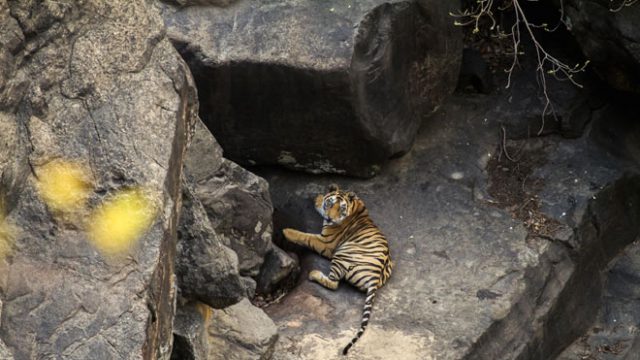As a regular visitor of India’s forests, the prospect of a maiden visit to Panna National Park didn’t really excite me. After all, in 2009, Panna declared itself ‘tigerless’. It was common knowledge that the lax park authorities had implicitly aided the mass slaughter of tigers, and four years seemed too short a span to replenish the park and stabilise a tiger population that had dropped to a naught.
Knowing the lackadaisical approach to most things in our country, I was certain that Panna’s struggle would be a long-drawn out affair that would mirror the fortunes of Sariska, another high profile park to have been emptied of tigers. But it wasn’t just the dearth of tigers that put me off; time and time again, we’ve seen jungles purged of their apex predators, lose their sheen, and morph into tepid tourist offerings. That’s where my reluctance to visit really stemmed from.
But nevertheless I landed up in Panna on a sweltering summer afternoon, and started to mentally prepare myself for what I thought would be a disappointingly drab evening safari. Oddly though, upon entering the park, I felt my cynicism, gradually but inexplicably, turn to revelry, in spite of the seeming paucity of big cats. Little did I realise that Panna had already started to cast its spell on me.
Panna was an aesthete’s fantasy—a spread of emerald green undulating into the horizon, tablelands that fall steeply at the edges to form majestic cliff faces, and the river Ken meandering through the jaw-dropping panorama, all evoked a sense of poetic perfection. The plentiful vistas aside, what genuinely satiated the soul was the all-encompassing tranquility, courtesy the low tourist influx. I felt like I had the park to myself, a feeling that’s hard to encounter in the more popular parks of the county.
In the absence of other clattery engines for company, we chose to turn off our own, bide our time, and let our auditory senses do the tracking. Half an hour later came our first clue—a sambhar bellowed somewhere close, signaling the presence of a predator in the vicinity. However, despite painstakingly searching the area twice over, the closest to we got to one was in the form of a Brown fish-owl, pensively perched atop a rock, casting forlorn glances all around. Whatever had alarmed the sambhar had slipped away. I had to temper my raised hopes and acquiesce to the fact that spotting a tiger in a park that was still in the throes of recovery was indeed too long a shot.
Then suddenly, on our way out of the park, just as my thoughts had started to drift away from the jungle, our gypsy came to a loud, screeching halt! At almost the same time, the guide screamed “leopard”! I deliriously scanned my surroundings, but to my utter dismay there wasn’t a single spot to be seen. My guide frantically pointed towards a point past the bonnet of the vehicle… and voila, crouched in the knee-high grass, in a manner that belied its sturdy, supple physique, was a well-camouflaged leopard. After reassuring itself that we meant no harm, the remarkably gorgeous beast got up on all fours, and nonchalantly strutted away, looking back once to cast a disdainful glance towards us.
I learnt later that the disappearance of their larger cousins left a gaping territorial void in the forest, and so the leopards duly took advantage, turning Panna into a thriving leopard habitat. However, as exhilarated as I was after the chance encounter, I worried if the fresh crop of tigers reintroduced from the other big ticket parks of Madhya Pradesh would manage to reclaim territory from their smaller, spotted brethren?

Once again, Panna pulled the proverbial rabbit out of the hat, making a complete mockery of my misgivings. I spent the greater half of my final hour in the park feasting my eyes on a majestic collared tigress (most of Panna’s tigers are collared, to keep them constantly under surveillance), who blessed us with a sublime spectacle by standing tall over the grass that had for so long conspired to keep her out of sight. A cheetal sauntered into the same grassy clearing soon after, getting dangerously close to the lurking tiger, completely unaware of its proximity. The air was rife with tension—was a hunt on the cards?
But alas, I stopped chewing my nails in anticipation as soon as I realised that the tigress wasn’t the only thing that the tall grass had been hiding; the tigress had been feasting on a half-eaten deer carcass. The icing on the cake was the heart-warming sight of two cubs that had broken cover to reveal themselves, as they followed their mother into another heavy thicket and vanished out of sight. The now empty grassy plain teased me with more secrets lying in store. It summed up the magic of Panna—there’s always more to this jungle than meets the eye.




